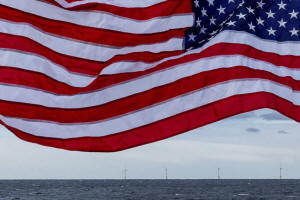Trump temporarily halts leasing and permitting for wind energy projects
 Send a link to a friend
Send a link to a friend
 [January 21, 2025] By
JENNIFER McDERMOTT [January 21, 2025] By
JENNIFER McDERMOTT
President Donald Trump signed an executive order Monday temporarily
halting offshore wind lease sales in federal waters and pausing the
issuance of approvals, permits and loans for both onshore and offshore
wind projects.
The interior secretary will review wind leasing and permitting practices
for federal waters and lands. The assessment will consider the
environmental impact of wind projects on wildlife, the economic costs
associated with the intermittent generation of electricity and the
effect of subsidies on the viability of the wind industry, the order
states.
Trump wants to increase drilling for oil and gas and has been hostile to
renewable energy, particularly offshore wind. Trump's pick for interior
secretary, Doug Burgum, was asked during his confirmation hearing
whether he would commit to continuing with offshore wind leases that
have been issued. Burgum said projects that make sense and are already
in law will continue.
Wind power currently provides about 10% of the electricity generated in
the United States, making it the nation's largest source of renewable
energy. There is 73 gigawatts of offshore wind capacity under
development in the U.S., enough to power 30 million homes, according to
the American Clean Power Association.
The order also temporarily prohibits Magic Valley Energy from continuing
to develop the Lava Ridge Wind Project in Idaho. The federal government
approved a scaled-down plan for the wind farm in December over local
opposition, including from groups concerned about its proximity to a
historic site where Japanese Americans were incarcerated during World
War II.

On the campaign trail, Trump vowed to end the offshore wind industry as
soon as he returned to the White House. He wants to boost production of
fossil fuels such as oil, natural gas and coal, which cause climate
change, in order for the U.S. to have the lowest-cost energy and
electricity of any nation in the world, he says.
It's unclear how much authority he has to stop wind projects,
particularly those that have their federal permits. His order will
likely be challenged in court, much like an executive order President
Joe Biden signed soon after taking office in 2021 that suspended new oil
and gas lease sales was challenged.
Soon after his election, Trump tasked a New Jersey congressman and vocal
critic of offshore wind, Republican Rep. Jeff Van Drew, with drafting an
executive order on offshore wind he could issue early in his term. Van
Drew said he quickly sent the draft to Burgum. Van Drew views the
executive order as a first step toward an eventual moratorium on
offshore wind development.
[to top of second column] |

The five turbines of Block Island Wind Farm operate, Dec. 7, 2023,
off the coast of Block Island, R.I., during a tour organized by
Orsted. (AP Photo/Julia Nikhinson, File)
 By including onshore wind projects
too, Monday's order is far broader than what Van Drew proposed.
Trump says wind turbines are horrible, only work with subsidies and
are “many, many times” more expensive than natural gas.
Offshore wind is among the sources of new power generation that will
cost the most, at about $100 per megawatt hour for new projects
connecting to the grid in 2028, according to estimates from the
Energy Information Administration. That includes tax credits under
the Inflation Reduction Act, which reduces the cost of renewable
technologies. But onshore wind is one of the cheapest sources, at
about $31 on average for new projects.
New natural gas plants are expected to produce electricity at nearly
$43 per megawatt hour, according to the estimates. The EIA said in
addition to price, it’s important to consider the reliability of the
grid — natural gas power plants can be operated at any time
throughout the day, unlike solar or wind.
Robin Shaffer, president of Protect Our Coast NJ, one of the most
vocal groups opposing offshore wind on the East Coast, said the new
executive order is only the first step toward the U.S. moving away
from offshore wind, a “harmful technology,” and toward more
promising, sustainable energy sources.
But Kit Kennedy, managing director for power at the Natural
Resources Defense Council, said the Trump administration is putting
dirty fossil fuels front and center while delaying progress on
renewable energy projects. This is not only bad for clean air,
public health and national security, it cuts short a promising
source of additional power at a time when the grid needs it most,
Kennedy said in a statement.
The Biden administration sought to ramp up offshore wind as a
climate change solution, setting national goals to deploy offshore
wind energy, holding lease sales and approving nearly a dozen
commercial-scale offshore wind energy projects. The nation’s first
commercial-scale offshore wind farm opened in March, a 12-turbine
wind farm called South Fork Wind 35 miles (56 kilometers) east of
Montauk Point, New York.
All contents © copyright 2025 Associated Press. All rights reserved
 |